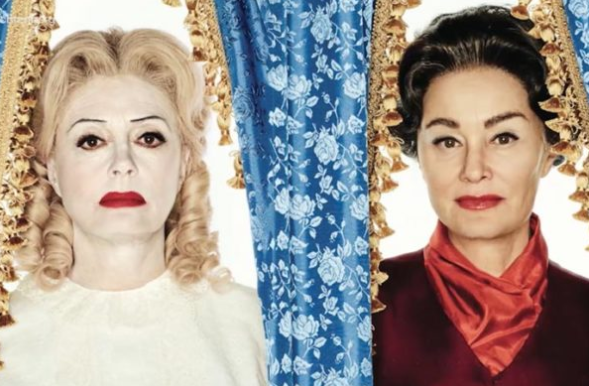Feud‘s debut has not only sparked delight over another American Horror-esque format for creator Ryan Murphy (the series will next focus on the contentious relationship between Prince Charles and Princess Diana), but also over the incredible attention to detail with which the script is written. Though, of course, it wouldn’t be a Murphy production without some sense of the grandiose and embellished–which is why one imagines the dinner Bette Davis (Susan Sarandon) and Joan Crawford (Jessica Lange) have at Hedda Hopper‘s Judy Davis) to possess some element of lore surrounding a fish jello concoction served as the main entree.
Set in 1961, when Davis is relegated to performing in a Broadway production of The Night of the Iguana, Crawford confronts her with a proposition: making Henry Farrell’s 1960 suspense novel, What Ever Happened to Baby Jane? into a movie. She even puts the cherry on top of her allurement by adding, “And I’m offering to you the title role.” Hesitant to bow down to any offer of Crawford’s, Davis remains overtly unconvinced, but in one of many unexpected moments of earnestness, Crawford breaks the state of affairs down to Davis by insisting, “If something’s going to happen, we have to make it happen. No one’s looking to cast women our age. But together, they wouldn’t dare say no. We need each other, Bette.”
In this regard, Feud addresses how prescient this issue in the industry would become as the decades wore on. And with this sentiment about ageism established, producer/director Robert Aldrich (Alfred Molina), knowingly goes into the lion’s den of multiple studios to pitch the project, using as his last resort Warner Bros.–but naturally he repackages his reasoning for coming to Jack Warner (Stanley Tucci) last because he knew it would be such a natural fit, a homecoming for both Davis and Crawford. This particular scene is what tints Feud with such a feminist slant as the exchange between Warner and Aldrich gears toward the former’s ire for Davis after she breached her contract with Warner Bros. in 1936 by accepting an offer to star in two British movies. At the time, Davis was dissatisfied with the trajectory her career was taking and felt that she was being offered paltry and insubstantial parts. It was ultimately her lawsuit that would, as Warner states to Aldrich, cause the entire house of cards to fall in terms of the contracts the studio system enjoyed. In fact, Olivia de Havilland (played by Catherine Zeta-Jones in Feud) would profit from Davis’ loss by launching her own similar case and winning in 1943.
However, when Aldrich tries to defend Davis’ reasoning in only wanting the most integrity for her career–the kind that men get to enjoy at all ages–Warner screams that she’s a (that go-to word men love to use for fiery women) cunt. Aldrich, knowing this is his last chance, continues to plead and bargain, offering to pay Warner first on all profits received from the film. And so it is that What Ever Happened to Baby Jane? goes into production, with each woman already trying to upstage the other from day one. In the scene where Davis first puts on her signature blonde Baby Jane wig, the costumer notes, “Joan wore this one in some early 1930s MGM melodrama, and from the looks of it, it hasn’t been touched since.” Smirking to herself, Davis puts the wig on and tops it with the clownish makeup that would make cinematic history. Her daughter, B.D. Hyman (Kiernan Shipka, who should really have upstaged Elle Fanning by now), looks on in shock and asks, “Are you sure that’s what you want to look like?” If it means outdoing Crawford, then of course the answer is yes.
Nonetheless, Crawford and Davis are bonded in the unity of being more alike in every way than any other actresses in the business in their desire for continued recognition while in an age bracket that no other actress had ever even managed to surmount while remaining a bona fide Hollywood star. Most of all, they are both sensitive with a tough exterior. In particular, a scene of Davis and Crawford watching the initial dailies of themselves hits each of them hard. Neither one is expecting herself to look quite so old on the screen, with Crawford complaining of unflattering lighting and then quietly leaving the room and Davis softly crying to herself as she realizes just how severe the ravages of time can be when placed on the silver screen.
Their battle to remain duly respected–with Crawford specifically wanting respect from Davis–is one that stems precisely from a patriarchal film industry in which women are ejected from grace more effortlessly than cutting remarks at Britney Spears from Katy Perry’s mouth (this will inevitably make for another season of Feud though). And it was only together that they were strong enough to fight against it in spite of much preferring to remain as separate individuals on the front lines of cinema glory.






















